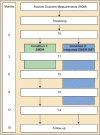A randomized controlled trial comparing the clinical efficacy and cost-effectiveness of eye movement desensitization and reprocessing (EMDR) and integrated EMDR-Dialectical Behavioural Therapy (DBT) in the treatment of patients with post-traumatic stress disorder and comorbid (Sub)clinical borderline personality disorder: study design
- PMID: 32762677
- PMCID: PMC7409691
- DOI: 10.1186/s12888-020-02713-x
A randomized controlled trial comparing the clinical efficacy and cost-effectiveness of eye movement desensitization and reprocessing (EMDR) and integrated EMDR-Dialectical Behavioural Therapy (DBT) in the treatment of patients with post-traumatic stress disorder and comorbid (Sub)clinical borderline personality disorder: study design
Abstract
Background: Comorbidity between Posttraumatic Stress Disorder (PTSD) and Borderline Personality Disorder (BPD) is high. There is growing motivation among clinicians to offer PTSD treatments - such as Eye Movement Desensitization and Reprocessing (EMDR) - to patients with PTSD and comorbid BPD. However, a large subgroup with comorbid BPD does not sufficiently respond to PTSD treatment and is more likely to be excluded or to dropout from treatment. Dialectical Behaviour Therapy (DBT) for BPD is well established and although there is some evidence that DBT combined with DBT Prolonged Exposure (DBT + DBT PE) is twice as effective in reducing PTSD symptoms than DBT alone, the comparative efficacy of integrated PTSD-DBT and PTSD-only treatment has not been investigated yet. The current study will therefore evaluate the comparative clinical efficacy and cost-effectiveness of EMDR-DBT and EMDR-only in patients with PTSD and comorbid (sub)clinical BPD. Moreover, it is not clear yet what treatment works best for which individual patient. The current study will therefore evaluate neurobiological predictors and mediators of the individual response to treatment.
Method: A randomized controlled trial comparing the clinical efficacy and cost-effectiveness of integrated EMDR-DBT (n = 63) and EMDR-only (n = 63) in treatment-seeking adult patients with PTSD and comorbid (sub)clinical BPD. In addition, neurobiological predictors and mediators of treatment outcome, such as hair cortisol, FKBP5 and BDNF protein levels and FKBP5 and BDNF methylation status, are measured through hair and blood samples.
Discussion: This is the first study to compare the clinical efficacy and cost-effectiveness of integrated EMDR-DBT and EMDR-only in patients with PTSD and comorbid (sub)clinical BPD, while simultaneously identifying individual predictors and mediators of treatment response. Results will reveal which treatment works best for which individual patient, thereby guiding individual treatment choices and personalizing psychiatry.
Trial registration: Clinical Trials, NCT03833453 . Retrospectively registered, 15 March 2019.
Keywords: Borderline personality disorder; Dialectical behaviour therapy; EMDR; PTSD.
Conflict of interest statement
The authors have declared that no competing interests exist.
Figures




References
-
- Ljungqvist I, Topor A, Forssell H, Svensson I, Davidson L. Money and mental illness: a study of the relationship between poverty and serious psychological problems. Community Ment Health J. 2016;52(7):842–850. - PubMed
-
- Walker EA, Katon W, Russo J, Ciechanowski P, Newman E, Wagner AW. Health care costs associated with posttraumatic stress disorder symptoms in women. Arch Gen Psychiatry. 2003;60(4):369–374. - PubMed
-
- Alonso J, Angermeyer MC, Bernert S, Bruffaerts R, Brugha TS, et al. Disability and quality of life impact of mental disorders in Europe: results from the European. Study of the Epidemiology of Mental Disorders (ESEMeD) project. Acta Psychiatr Scand. 2004;109:38–46. - PubMed
Publication types
MeSH terms
Associated data
LinkOut - more resources
Full Text Sources
Medical
Miscellaneous

